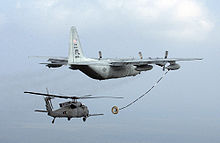1st Expeditionary Rescue Group
It was activated in Southwest Asia in September 2015 to provide combat search and rescue for Operation Inherent Resolve.
[4] The squadron left for overseas from Camp Patrick Henry, Virginia,[5] sailing on board the SS William L. Mitchell on 3 March.
[6] The squadron arrived at the port of Casablanca, French Morocco on 12 March and proceeded to the encampment at Camp Don B.
They staged through Sidi Ahmed, Tunisia before arriving at their operational station of Ajaccio, Corsica, France.
Its first rescue, of a crewmember of a Royal Air Force Vickers Wellington bomber, occurred a week later.
On 10 May the squadron staged a rescue operation from Vis, an island controlled by Yugoslav Partisans in a search for a fighter aircraft downed over Yugoslavia.
A Flight performed the first rescue flown from Italy, landing a Catalina a few miles off the coast of Albania to pick up the pilot of an RAF Supermarine Spitfire who had been shot down while attacking a German Q-Ship.
[1] The move to Foggia also brought the assignment of Boeing B-17 Flying Fortresses, transferred from units in Fifteenth Air Force.
[1] A Flight was located with the squadron until early 1951, when its personnel were distributed to other Air Rescue Service units.
[18] In 1951 the squadron headquarters returned to the Canal Zone, moving to Albrook Air Force Base,[1] where its B Flight was already located.
[21] The squadrons had previously reported to the 1st Operations Group, stationed at Langley Air Force Base, Virginia.
[1][22][23] The group provided rescue, recovery and medical evacuation capability for Space Shuttle launches.
The need for a rescue capability as part of Inherent Resolve was highlighted by the failure to recover Muath al-Kasasbeh, a Royal Jordanian Air Force pilot, who was captured by ISIL, then tortured and barbarously killed after his fighter crashed in Syria.
This article incorporates public domain material from the Air Force Historical Research Agency



